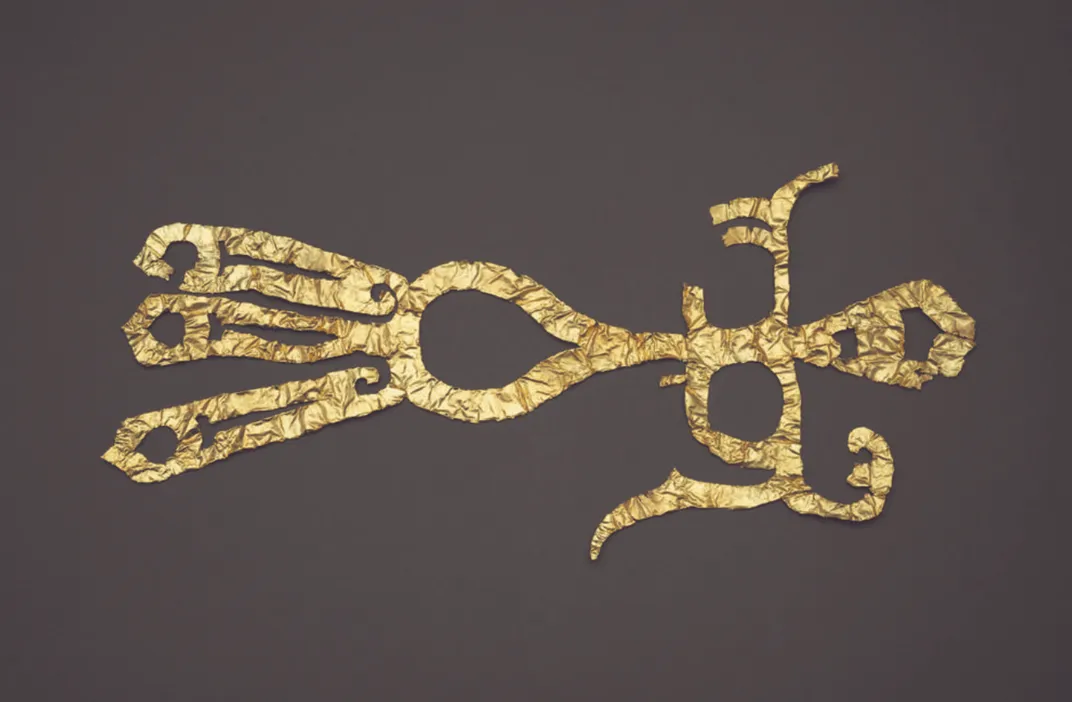3,000-Year-Old Gold Mask, Silk Linked to Enigmatic Civilization Found in China
The state of Shu left behind few written records. A trove of 500 newly excavated objects may offer insights on the mysterious kingdom
:focal(2020x1300:2021x1301)/https://tf-cmsv2-smithsonianmag-media.s3.amazonaws.com/filer/d1/de/d1de1028-9831-469f-8d00-18e9bd346723/gettyimages-1231822972.jpg)
Archaeologists have uncovered a trove of 3,000-year-old artifacts—including fragments of a gold mask—at Sanxingdui, an excavation site in China’s Sichuan province.
As Stephen Chen reports for the South China Morning Post, the researchers, who began digging at the site in 2019, found more than 500 objects, most of which were crafted out of gold, bronze, jade and ivory.
Experts are unsure who made the artifacts, but they speculate that the cache’s creators belonged to the Shu state, a highly skilled civilization conquered by the neighboring state of Qin in 316 B.C. Because the people of Shu left behind few written records, notes Oscar Holland for CNN, historians’ knowledge of their culture is limited.
A major highlight of the find is a 0.6-pound fragment of a gold mask that may have been worn by a priest during religious ceremonies, reports the Global Times’ Chen Shasha. About 84 percent pure gold, the piece likely weighed close to one pound in its entirety, making it one of the heaviest gold masks from that time period discovered in China to date. The Sanxingdui team found the mask, along with an array of other ornate items, in six rectangular sacrificial pits.

According to a statement from China’s National Cultural Heritage Administration, other discoveries made at the site included two kinds of silk. The first was found scattered among the ashes in one of the pits, while the second was found wrapped around bronze objects.
Silk has played an important role in China’s millennia-old history. As the statement points out, the ancient inhabitants of Sanxingdui probably wore silk garments during sacrificial ceremonies. The fiber was thought to serve “as a carrier and medium for communication between heaven, earth, man and god,” notes the statement, per Google Translate. Outside of these religious rituals, silk was used to make fine clothing, fans, wall hangings and banners, as Mark Cartwright wrote for Ancient History Encyclopedia in 2017.
Civilizations across the ancient world, from Rome to Persia to Egypt to Greece, similarly revered Chinese silk, sending traders along the Silk Road to obtain the highly sought-after fabric.
As Tang Fei, head of the excavation team and chief of the Sichuan Provincial Cultural Relics and Archaeology Research Institute, tells state-run news agency Xinhua, the presence of silk at Sanxingdui indicates that “the ancient Shu Kingdom was one of the important origins of silk in ancient China.”

Other key discoveries included bronzeware adorned with depictions of beasts and birds, ivory carvings, and gold ornaments. Some of the artifacts bear distinct similarities to objects found along the Yangtze River and in Southeast Asia, suggesting that the enigmatic Shu civilization engaged in “broad exchanges with many areas,” says Zhao Congcang, an archaeologist at Northwest University in Xian, to the Post.
A local farmer stumbled onto jade and stone artifacts at Sanxingdui while repairing a sewage ditch in 1929, wrote Tia Ghose for Live Science in 2014. Since then, researchers have uncovered more than 50,000 ancient items at the site: A major excavation in 1986, for example, revealed two ceremonial pits containing more than 1,000 items, including intricate, well-kept bronze masks, according to CNN.
Experts uncovered a third pit in 2019 and five more last year. Scholars posit that ancient people used these ditches for ritual sacrifices, as many of the items were burned before they were interred.
Song Xinchao, deputy director of the National Cultural Heritage Administration, tells Xinhau that the findings are poised to “enrich and deepen our understanding of the Sanxingdui culture.”
Though Sanxingdui, which has yielded finds dated as far back as the 12th and 11th centuries B.C., isn’t currently acknowledged as a Unesco World Heritage Site, it remains in consideration on a “tentative list.”
/https://tf-cmsv2-smithsonianmag-media.s3.amazonaws.com/accounts/headshot/Isis_Davis-Marks_thumbnail.png)
/https://tf-cmsv2-smithsonianmag-media.s3.amazonaws.com/accounts/headshot/Isis_Davis-Marks_thumbnail.png)